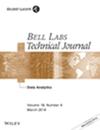下载PDF
{"title":"A New Perspective on Burst-Switched Optical Networks","authors":"Giorgio Cazzaniga, Christian Hermsmeyer, Iraj Saniee, Indra Widjaja","doi":"10.1002/bltj.21630","DOIUrl":null,"url":null,"abstract":"<p>Recent experimental research in coherent detection has enabled 100G (or higher bit-rate) optical receivers to switch between wavelengths in less than a hundred nanoseconds. Such technologies enable a novel variant of the Time-domain Wavelength Interleaved Networks (TWIN) architecture in which fast tunable receivers replace tunable transmitters as the main switching elements in the otherwise passive optical network. Similar to TWIN, this architecture enables efficient sharing of 100G (or higher) wavelength rates among multiple destinations in metro networks or data centers where individual node-pairs may not need the full capacity of each wavelength. In this paper, we present the key elements of this novel variant of TWIN, discuss framing and scheduling efficiency, sub- and super-framing for TDM and packet data, as well as protection mechanisms. We also present the benefit of this approach relative to other optical network technologies. We conclude with an overview of the potential applications of this novel optical networking architecture. © 2013 Alcatel-Lucent.</p>","PeriodicalId":55592,"journal":{"name":"Bell Labs Technical Journal","volume":"18 3","pages":"111-131"},"PeriodicalIF":0.0000,"publicationDate":"2013-11-27","publicationTypes":"Journal Article","fieldsOfStudy":null,"isOpenAccess":false,"openAccessPdf":"https://sci-hub-pdf.com/10.1002/bltj.21630","citationCount":"8","resultStr":null,"platform":"Semanticscholar","paperid":null,"PeriodicalName":"Bell Labs Technical Journal","FirstCategoryId":"1085","ListUrlMain":"https://onlinelibrary.wiley.com/doi/10.1002/bltj.21630","RegionNum":0,"RegionCategory":null,"ArticlePicture":[],"TitleCN":null,"AbstractTextCN":null,"PMCID":null,"EPubDate":"","PubModel":"","JCR":"Q1","JCRName":"Engineering","Score":null,"Total":0}
引用次数: 8
引用
批量引用
Abstract
Recent experimental research in coherent detection has enabled 100G (or higher bit-rate) optical receivers to switch between wavelengths in less than a hundred nanoseconds. Such technologies enable a novel variant of the Time-domain Wavelength Interleaved Networks (TWIN) architecture in which fast tunable receivers replace tunable transmitters as the main switching elements in the otherwise passive optical network. Similar to TWIN, this architecture enables efficient sharing of 100G (or higher) wavelength rates among multiple destinations in metro networks or data centers where individual node-pairs may not need the full capacity of each wavelength. In this paper, we present the key elements of this novel variant of TWIN, discuss framing and scheduling efficiency, sub- and super-framing for TDM and packet data, as well as protection mechanisms. We also present the benefit of this approach relative to other optical network technologies. We conclude with an overview of the potential applications of this novel optical networking architecture. © 2013 Alcatel-Lucent.
突发交换光网络的新视角
最近在相干探测方面的实验研究已经使100G(或更高比特率)光接收器在不到100纳秒的时间内在不同波长之间切换。这些技术使时域波长交织网络(TWIN)架构的新变体成为可能,在这种架构中,快速可调谐接收器取代可调谐发射器,成为无源光网络中的主要交换元件。与TWIN类似,这种架构可以在城域网络或数据中心的多个目的地之间有效地共享100G(或更高)波长速率,其中单个节点对可能不需要每个波长的全部容量。在本文中,我们提出了这种新型TWIN的关键要素,讨论了分帧和调度效率,TDM和分组数据的子帧和超帧,以及保护机制。我们还介绍了这种方法相对于其他光网络技术的好处。最后,我们概述了这种新型光网络架构的潜在应用。©2013阿尔卡特朗讯
本文章由计算机程序翻译,如有差异,请以英文原文为准。


